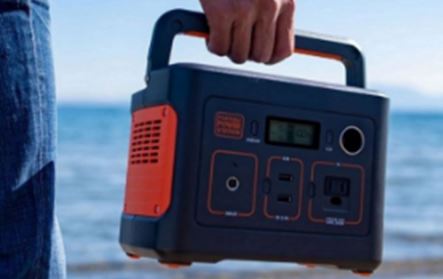Portable power stations offer a dependable source of power in the event of a grid outage and can also serve as a remote power source for recreational activities away from home. Because they are compact and lightweight, portable power stations are a great way to have access to power away from home while camping, tailgating or on long car trips…and they can also serve as a backup source of power for a limited number of appliances in your home during an outage from the grid.
It might be helpful to do a quick review of three most popular backup power products so you can see where portable power stations fit in terms of size, capacity and best applications. In order of size and power generating capability, the three leading backup power products are:
***Permanent standby generators. These are larger systems placed on a permanent pad outside the home and are powered by natural gas line, diesel fuel or liquid propane. These systems can immediately detect a loss of power from the local utility and will transfer power generation to the standby generator system (and away from the utility) via a “transfer switch”. Permanent standby systems are capable of assuming your building’s full voltage workload from your utility and should be installed by a licensed electrician who is experienced with this kind of work. While these systems are more costly than portable generators and portable power stations, they can deliver power to your entire home or business and can operate automatically when you are not present.
***Portable generators. These are smaller systems that can be wheeled or carried to any location and are powered by gasoline. At your home or business, extension cords running from the portable generator deliver power to a number of appliances such as a furnace, refrigerator, hot water heater, TV, sump pump and lights. Away from home, portable generators can run small appliances at campgrounds, near your RV and, based on capacity, can run mini fridges, space heaters, flood lights and stereos. Portable systems can be purchased at your local home improvement store and do not require installation by a licensed electrician. While portable systems are less costly than permanent standby systems, they have less capacity. Again, they are ideal to be used where you need to power a smaller group of appliances, not an entire home or small business.***Portable power stations. Portable power stations are typically smaller than portable generators and can range in sizes as small as a clock radio to as large as a small suitcase. Their ability to deliver power comes from batteries that can be recharged via an AC outlet, a 12V car cigarette lighter or by a portable solar panel. While most portable power stations have less capacity than the average portable generator, they are very light (~5-25 pounds) and easy to carry around. They also operate very quietly, without any discernible sound. Portable power stations are designed to power a limited number of small appliances such as a TV, a stereo, bluetooth speakers, flood lights and a mini refrigerator. There are non-recreational uses as well, including jump starting vehicles, powering air compressors and spray washers. Interestingly, those with sleep apnea can even power their CPAP devices while off the grid on camping trips. Portable power stations have multiple outlets that you can use to make appliance connections. They also have USB ports that allow you to charge technology devices such as laptops, smart phones and Go Pro cameras. And speaking of electronic devices, it is worth noting that most portable power stations have inverter technology, which delivers smooth, clean power that will not damage sensitive microprocessor-based devices like TV’s, laptops and smart phones. The small footprint and quiet operation of portable power stations makes them ideal for camping trips, RV trips and tailgates, where you may have neighbors close by that might not appreciate having the sound of a gas-powered portable generator nearby.How To Charge a Portable Power Station.Portable power station batteries are typically charged by making a connection to an AC wall outlet, a USB port on a computer or via a connection to a 12V car cigarette lighter. In addition, with the “off grid warriors” in mind, many manufacturers have enabled their power stations to be charged via solar panel charging systems, which usually come as an optional accessory. Generally speaking, the most rapid form of charging is with an AC outlet (~5-8 hours), followed by a 12V car cigarette lighter (~10 hours) and a solar panel (~10-15 hours, depending on the weather).Manufacturers have made it easier for owners to detect when a charge is needed. Quite a few power station units come with an LED indicator that tells you how much battery power you have remaining in terms of hours and minutes. Most portable power stations will detect a full charge and automatically stop charging when the battery is full. While some portable power stations can hold over 90% of their charge for up to a year, it is a good idea to recharge your battery every 30-60 days when your unit is not being used. This will not only extend the life of your battery but it will ensure that your power station can be ready for you to use at any time.How Long Does a Charge Last?Most portable power stations generate their power from lithium batteries. How long a fully charged portable power station will last depends on the size of the unit as well as how many (and what kind of) appliances are connected to the unit. To give you a sense, an average-sized power station is the 11 lb. RIVER Black EcoFlow, which measures roughly 10″ x 6″ x 8″ and is rated to power a mini fridge for 10 hours, charge a smart phone 30 times and a laptop 5-9 times. On the company website, there was a testimonial from a “track Mom” who said that a track meet, her RIVER Black unit powered a 24″ TV, an X-Box and charged two iPhones for a full 6 hours with plenty of power to spare. As a consumer, you have many choices with regard to power stations and you should have no problem finding a unit that suits your specific needs. If you are concerned about an extended grid outage or if you will be away from a charging source for an extended period, purchasing a solar panel attachment is a good idea. When shopping for a portable power station, you can compare units by measuring key variables such as output power as measured by watts, capacity as measured by watt hours (Wh), number of ports (AC, DC, USB), battery type and useful life (as measured by number of cycle charges).Advantages vs. GeneratorWhile portable power stations have less power capacity than most portable generators, they offer many advantages. To begin with, they have a small form factor (ranging in size from a clock radio to a small suitcase) and do not weigh much (less than 25 pounds), making them very easy to store in a car or RV and easy to move around. Recharging batteries is easy via an AC outlet, a USB port, car cigarette lighter or solar panel and does not involve transporting spare gasoline which can be cumbersome and possibly dangerous. Operation is quiet, making power stations ideal for camping and tailgating, where the noise from a gas-powered generator could annoy others. And with most portable power stations containing inverter technology (highly recommended), you can safely charge and power your most sensitive electronic devices such as iPhones, tablets, laptops and movie cameras. In sum, a portable power station can be an ideal source of backup power for a limited number of appliances at home during a grid outage or for trips away from home. For those needing to power an entire home, a gas-powered portable generator or a permanent standby generator may be the best option.Lithium vs Other?In recent years, manufacturers of portable power stations have been moving away from lead acid batteries to lithium batteries as they offer several key advantages: (1) they are smaller and much lighter (2) they have more power capacity or “energy density” (3) they can be recharged more quickly and (4) they lose their charge at a much slower rate when not in use. Drawbacks of lithium batteries include higher cost, sensitivity to extreme hot weather and the inability to carry on planes without permission. But overall, the shift to lithium batteries has made portable power stations more versatile, reliable and easy to use for the average consumer.

